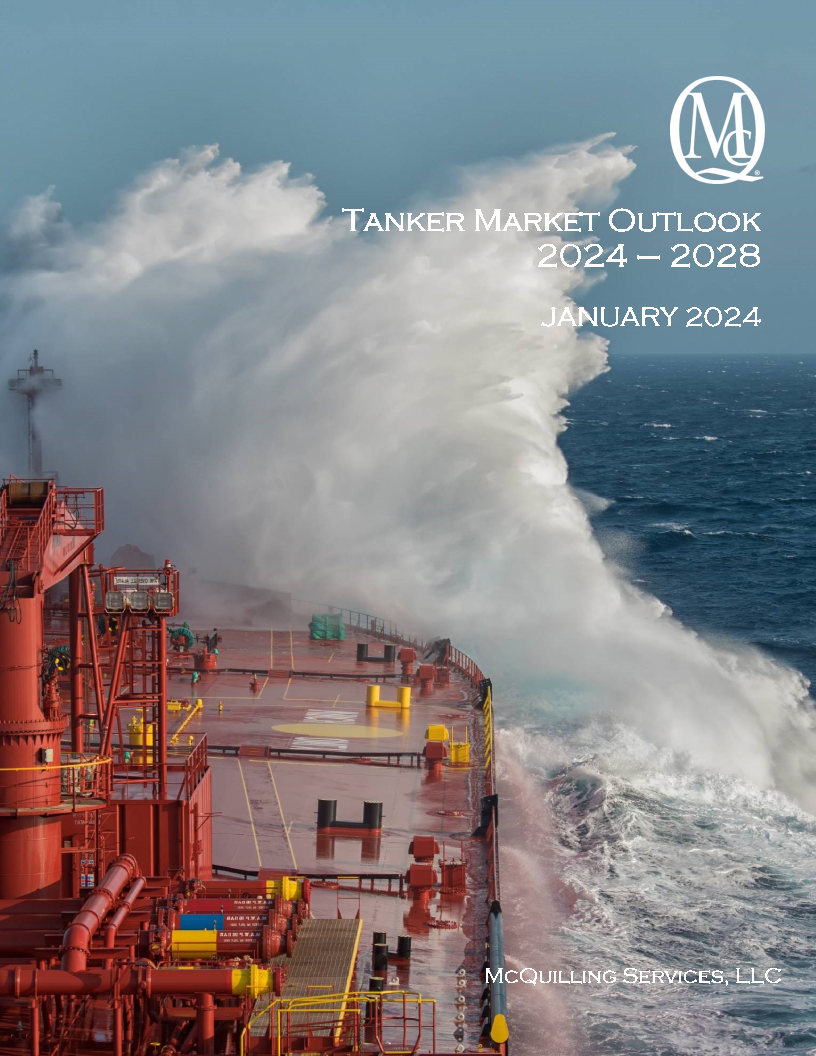McQuilling Services Announces the Release of the 2024-2028 Tanker Market Outlook

McQuilling Services Announces the Release of the 2024-2028 Tanker Market Outlook
New York – January 30, 2024 – McQuilling Services is pleased to announce the release of its 27th anniversary edition, 2024-2028 Tanker Market Outlook. This 196-page report provides a detailed analysis of oil fundamentals, global economic and geopolitical context in addition to tanker demand and supply projections across eight vessel classes. The interaction of tanker demand and vessel supply variables is processed using advanced quantitative modeling to produce a five-year spot and time charter equivalent (TCE) forecast for eight vessel classes across 27 benchmark tanker trades, plus five triangulated trades. Given the Our forecasts are prepared on a “Status Quo” basis, however, we have synthesized the most recent market shocks, including tanker rerouting due to the Red Sea tensions. In this report, our clients are provided proprietary vessel demand assessments and correlated earnings forecasts from these geopolitical scenarios.
“Is it a Black Swan or the New Norm?” has become a regular theme for our Tanker Market Outlook report recently with the geopolitical risks arising from the conflicts in Eastern Europe and the Middle East, while an uncertain economic outlook and OPEC’s production outlook introduce parallel risks. Meanwhile, massive infrastructure projects, including new refineries and export terminals are coming online during our forecasting period, introducing new trade flows and associated tanker demand changes. While navigating these volatile markets, industry participants are also facing stricter environmental regulations including EU ETS, CII and EEXI, which will impact market behavior.
Our prevailing view for the crude tanker markets continues to favor the mid-sized tankers over VLCCs in 2024 as major VLCC hubs - Middle East and West Africa - reveal tighter crude balances. The year 2025 is expected to find VLCC demand on the rise (+3.9%) as OPEC production increases and a potential contango structure support higher VLCC utilization in the context of a dwindling orderbook. The lifting of US sanctions on Venezuela will notably support conventional VLCC demand to Asia, along with Aframax flows to the USG. Canada’s new pipeline (TMX) project is estimated to commercialize in 2H 2024. Due to the draft limitations, Aframaxes (and Panamaxes) will benefit the most to export Canadian crude, introducing new trading patterns in the Pacific Basin market, which will likely come with a plethora of inefficiencies outlined in the report.
The tanker markets will continue rebalancing through tanker additions and demolitions, albeit gradually for larger tankers. However, Aframax/LR2 fundamentals have incentivized skewed NB orders (105) in 2023 compared to only 17 VLCC orders, resulting in our models revealing VLCCs to outperform smaller crude tanker sectors by late 2025. Our calculations amid Red Sea developments reveal a negative impact (-$8,300/day) on VLCC earnings should Saudia Arabia maximize its East-to-West Pipeline throughput, while Aframax TCEs may increase by $42,400/day from the base case.
Recapping our views from last year’s report, product tanker earnings in 2023 remained well-above the historical averages, with our MR projections from January 2023 coming within US $100/day of full-year actual levels as we correctly called the re-shuffling of Russian products to more distant regions, including Brazil. Following our views from last year, the “Price Cap” on Russian CPP exports has seen and will continue to witness a strong pull of Middle Eastern and US Gulf diesel to Europe. With Russian barrels losing market share in Europe, cargoes are projected to continue sail longer distances to Africa (gasoline), Latin America (diesel) and Asia (naphtha). In 2024, we project the increasing West African refining capacity to pressure CPP demand for the Europe>West Africa gasoline flow, but concurrently increase LR demand for European gasoline length traded to Southeast Asia and East/South Africa. Similar flows for USG naphtha and gasoline should be revealed in the context of higher domestic gasoline supply in Mexico and an uncertain demand environment in the United States, adding length to the balance. Increased distillate supply in the East of Suez from new and expanded refineries will flow to the West in larger quantities as distillate inventories in Europe have eased from this time last year, although longerterm diesel demand in Europe appears to be on shaky footing due to decarbonization efforts.
Due to our view on the outperformance of mid-sized tankers, our forecasting models show secondhand values for Aframax and LR2 tankers have the most upside from current assessments over the next two years, before the next cycle reveals itself around the end of our forecast period. The tight yard capacity and high NB pricing will temporize the pace of fleet growth, although our models show a marked rise in additions at the end of the cycle. However, structural concerns around shipyard throughput stemming from challenging demographics introduce a scenario whereby future deliveries underperform our projections and further extends the duration of this upward cycle for tanker earnings.
Purchasing
McQuilling Services’ 2024-2028 Tanker Market Outlook can be purchased online at www.mcquilling.com/reports-all, by email to services.us@mcquilling.com or by calling 516-227-5774.
McQuilling Services is the marine transportation consulting and advisory group of McQuilling Partners, Inc. The primary focus of McQuilling Services is to provide clients commercial consulting services related to global seaborne transportation and related disciplines in the supply chain. The approach of the Company is to develop products and services based on specific client requirements, data, and the systematic employment of quantitative methods, bringing individually crafted solutions to client’s needs. The Company employs a collaborative business model combining experienced internal resources with exceptional industry partners to produce a team of directed experts. This model creates a targeted, content-rich knowledge and experience base to serve clients’ needs cost effectively.









